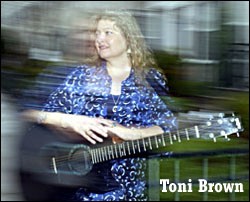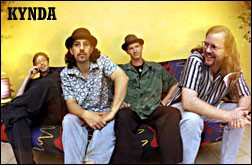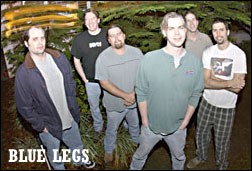With more than three decades of clichés, misconceptions and a not insubstantial amount of substandard music ascribed to the "jam band" movement, it's a pretty intimidating burden of proof that the next wave of musicians in the loose-limbed, improvisation-heavy scene faces. But, despite a limited local profile and the aforementioned stereotypes, a clutch of Orlando bands are forging forward by creating their own mini-scene in Central Florida. Yes, in true flower-child parlance, they're quick to refer to themselves as "family," but, across the board, they equally reject the "hippie" moniker and insist that, rather than aligning with one particular sound or style, they just want to have a good time.
Four of these bands -- Kynda, funkUs, Bluelegs and the Toni Brown Band -- will come together March 19 for Jambando at Hard Rock Live, a sort of minifestival highlighting the talents of the burgeoning scene. In its second year, Jambando organizers hope the event will show the community how healthy -- and creatively viable -- the local jam scene is and, more importantly, bring some new faces into its family.
"The Orlando music scene has so much quality music in it," says Dave Mann, guitarist for funkUs and initiator of Jambando. "We don't think `the jam band` scene is better than any other, but we do have a great time doing it and we just want more people to know, and to come party."
The roots of the national jam band scene lead, of course, back to the Grateful Dead. The group's psychedelic and improvisation-heavy heyday in the early and mid-'70s was a watershed for bands looking for a creative continuation of the sounds pioneered under the warm glow of lava lamps. As a departure from the pop-song-centric standards of the music industry, the sound -- whether the patented noodling of the Dead or the brain-fried boogie of the Allman Brothers -- connected with the lost tribes of hippies, who, no longer a bankable pop culture commodity, had become something of a self-contained clan for disaffected youth across America.
"They played no set time limits, no three-minute songs, and never went commercial," says Toni Brown of the primary reason this first wave of "jam bands" was so appealing. Brown was formerly the editor and publisher of the magazine Relix, which began in the early '70s to unify the community of Dead fans who taped concerts and, in its own way, contributed mightily to uniting and defining the scene; through Relix, the community of fans grew larger and more connected.
As the scene grew, it was only natural that a second wave of bands would emerge. Though clearly beholden to the tradition established by their precursors, when bands like Phish, Blues Traveler and Widespread Panic emerged in the late '80s and early '90s, the sound had begun to expand even more. Although these bands and their fans placed a similar emphasis on community and infinitely expandable live performances, Jerry Garcia never played a vacuum cleaner on stage. Another characteristic these bands shared with their predecessors was near-unanimous critical derision, based primarily on stereotypes about the music and its fans.
However, a third wave of jam bands -- like the local groups playing Jambando -- has emerged across the country, both inspired and chastened by the reputations and repertoires of those that jammed before. Musically, they draw a sharp contrast between themselves and the first two waves, with sonics as beholden to P-Funk and John Coltrane as anything else.
Within the local scene, Kynda delves into sophisticated improvisation, while funkUs digs deeply into a jazz, blues and (obviously) funk bag, able to turn a James Brown hook into a 15-minute exploration. Bluelegs, a reincarnation of the jam band Refried Confusion, formed for last year's Jambando with the sole purpose of experimental explorations. Ex-Relix editor Brown's eponymous band rounds out the lineup for this year's festival with folksy, acoustic rock.
"It is musically the most open scene there is," says Mann. "No jam band can be pigeonholed in any particular style. It is a wide-open scene that draws on a lot of influences, and the fans are more appreciative of a wider range of music."
Pat Campbell is one of those fans. A Grateful Dead tape collector, he began attending Kynda shows in 1996, after meeting neighbor Tony Hume, Kynda's guitarist. He has attended almost every local show since, and now keeps track of set lists and writes show reviews on the band's online discussion forum.
"I thought I would just go see him because he was my neighbor," says Campbell. "At first, I wasn't sure. But I went again, and realized they weren't half bad. It is amazing how far they have come since 1996. They are evolving and each week I hear something I didn't before."
That evolution is something that Kynda keyboard player Pete Orenstein equates to the maintenance of a relationship with a significant other. Just like marriage, he says, the worst thing that could happen would be for things to get stagnant.
"The only way to make it work is to keep growing and keep evolving," says Orenstein. "Every show has to be better than the previous show, and you always have to rethink what you are playing, to step up and play it differently each time."
"Sometimes we're less accessible to the mainstream because we experiment," says Carter Everett, lead guitarist for Bluelegs. And though the idea of challenging an audience would be anathema to many bands, Everett admits that "people find they acquire a taste for the music quickly."
"We scare people sometimes, although not intentionally," says Ron Betts, lead singer for funkUs. "We're not DJs, and we're not pop. When people see us, they don't know what to expect."
Symbolizing more than just four individual groups of musicians, the bands taking part in this year's Jambando have long, intertwined histories that speak as much to a "family" vibe as to shared philosophies about music. Their members have cross-pollinated over the past two decades, playing in various combinations of ensembles until finding their niche. To track their past amalgamations, one needs a genealogical chart, and it's not unreasonable to expect that further permutations will emerge.
"Over the years, it has been a pond of people that made different bands at different times," says Jim Mahoney, who plays bass with funkUs.
"It's been evolutionary," says Brown. "It's amazing that so many bands come into the circle."
That circle is one that, though fortunate to have a devoted and growing fanbase, is at odds with the commercial music scene. The bands point to the current limbo of the music industry -- plagued by falling album sales and the digital music phenomenon -- and embrace the growing grassroots support of their organic, independent music. After all, if the music of jam bands offers nothing else, it's an unmitigated embrace of the live experience.
"While the commercial music industry has fallen flat, the jam band scene is thriving," says Brown. "We have never been commercial. We have nothing to lose."
Despite national successes for the "scene," the Orlando bands that are participating in Jambando face the same plights shared by most players of original music in the city: jaded audiences, obstinate club owners and, perhaps most daunting, the shadow cast by the Mouse over Orlando's national reputation. Ironically though, the jam band scene is perhaps the only one in Orlando to actually benefit from proximity to the parks. Although there are few venues in town that book the bands consistently, the ones that do are odd oases: Irish pubs spitting distance from the entrances of Walt Disney World (Kitty O'Shea's) and Universal (Reilly's Lantern Pub). Though both bars host a variety of music, jam bands were the first live acts to play these venues and, to this day, are a mainstay of their live music schedules.
That unlikely locale is indicative of the difficulty these bands are having in reaching their core audience, and they all note that their fanbase is disconnected, without the sort of community grapevine shared by many national -- or even regional -- bands. Even Brown, whose years with Relix certainly attuned her to sniffing out this sort of music, lived in Orlando for a year and a half before stumbling onto the local scene.
"I sat on my couch for two years," says Brown. "I couldn't believe it took me so long, especially with my background. It's just difficult to know what is going on in Orlando when you first get here."
But with an event like Jambando, it's reasonable to expect the fans and bands to coalesce into something resembling the proactive communities that sprouted up around the city's punk and metal scenes. Plus, local jammers offer something that their famous counterparts can't: reasonable prices for quality live music on a regular basis.
"Ticket prices now are so astronomical that you have to pick and choose what show you want to go to, instead of going to a cheap show and seeing four main bands," says Mahoney.
What will carry the scene through is family. Musicians and longtime fans both equate the scene to a family. Each band points to the welcoming crowd of fans as the reason they continue playing.
"As awkward and silly and hokey as it might sound to people, it's relating to each other in a family-like atmosphere," says Hume. "I would not consider myself by any means a hippie, but in the aspect of treating each other as brothers and sisters, the hippie feeling has carried into our scene.
"It's about an exchange of energy. You're surrounded by a happy, supportive crowd, and the music just flows naturally."
And, just like most families, the members of the Orlando jam scene tend to look alike. Although the crowds and the players easily cross ethnic and socioeconomic boundaries, it doesn't take long to notice that there are very few female musicians in the scene.
"That will soon change, once people know we are here," says Brown, the only woman playing at Jambando. "Women will find their space in this scene, they just have to come out and play finally."
Another conspicuous absence is that of former Grateful Dead fans. Though all the bands would be quick to insist that they're far from being Jerry clones, the sonic lineage from the Fillmore through Phish shows to Jambando is pretty clear, which makes it surprising that the folks who were there at the beginning aren't here now.
"The older fans should be out here," says Brown. "This is their music, they just haven't heard about it yet."
Once they do, the musicians are confident that their following will grow. They feel the scene simmering beneath Orlando's surface, and they're confident it will bubble over.
"There is a change in the air, for all of us in our scene, because people are catching on," says Mann. "It really feels like the edge of something, which is why we are bringing everyone together to have a big party and share that common experience."
"It is a really important time right now, like in the early 1990s before grunge came out," says Betts. "There was a void where there was no good music coming out, and we are at another juncture like that now. What comes out of it is going to be exciting, and I hope we are a part of it."





